

 |
 |
 |
a trend creation |
 |
 |
 |
| History | Cut
|
Color |
Clarity |
Carat |
Famous |
Color Stone |
Birth Stone |
Care | How to Buy |
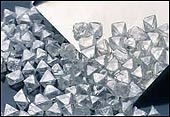 |
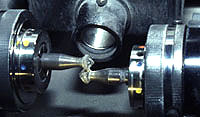 |
CUT

The cut of a
Diamond is the
only property, which is very dependent on man. Although often
overlooked, cut
is actually one of the most important aspects to consider when choosing
your
diamond. A Diamond cutter analyzes the rough diamond, and has to
determine how
to extract the most beauty and most profit out of the rough stone. Cut
refers
to not only the shape of the diamonds, but its proportions and finish,
factors,
which determine the sparkle of the diamond. It is possible to take the
same
stone, and depending on which method the cutter decides to use, to
either cut
it into the most beautiful stone it can be despite heavy weight loss
and
perhaps lower monetary value. Else, he can cut a stone to its maximum
weight
and monetary value, but lose some "brilliance" and
"sparkle"! You see, even if you have two equal polished diamonds,
both the same carat size, both the same color, both the same clarity,
they may look
completely different. How there are many different shapes, and facets
in a
diamond. The weight can be distributed in different parts of the stone.
For
example, here's a picture of what is called in the Diamond industry an
ideal
cut stone. The goal in terms of extracting the greatest beauty from a
Diamond,
is to have light enter a Diamond, disperse the light as it bounces
inside the
Diamond, thereby producing the different colors and sparkly effect, and
finally
returning as much light to the eye as possible. According to
conventional
wisdom, the proportions shown above are the best for maximum light
return. The
2-dimensional illustration below shows the theoretical path a ray of
light will
take through an ideal-cut Diamond.
What is the
proportion of
the diamond?
 |
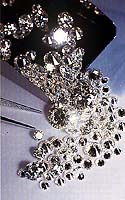 |
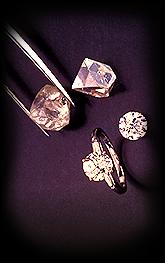 |
Round brilliant
diamonds are
commonly cut with 58 facets. The better proportioned these facets are
on the
diamond; the more light will be reflected back to the viewer's eye.
This is
extremely important. When cut properly, the diamond will sparkle more.
Diamond
cuts are measured by the table percentage, so always ask for it. A good
table
percentage is between 55-60%. Cut also refers to the shape such as:
round,
pear, heart and oval. If you are having a diamond mounted, write down
the
measurements of your stone. Measurements never change. A measurement of
the
stone after it is mounted and verifies and that it matches the
appraisal and/or
certificate. The diamond's cut is classified by the GIA as Excellent,
Very
Good, Good, Fair and Poor (Re-cut).
Refers
picture to
the angles
and proportions of a diamond.

| When a diamond is cut too shallow, light escapes through the bottom, reducing the brilliance of the stone, making the general appearance watery glassy and dark. |
| When a diamond is cut too deep, light escapes through the bottom, reducing the brilliance of the stone, making the center appear dark. |
| In ideal cut light entering, the diamond reflects internally from facet to facet and is reflects back out to the top. Therefore, an ideal cut yields maximum brilliance. |
The measurement
and
proportion of all these cuts determines the grade of the cut that is
given by a
gem lab. There are five grades given:
Excellent
(Ideal)
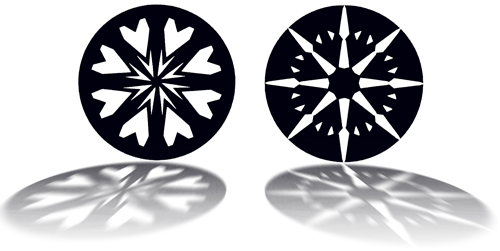
Strict standards
and
mathematical proportions produce the maximum amount of reflected light
and
brilliance through the stone. Symmetry is a key element here, and thus
the only
stones with an ideal cut will be round ones.
However, an ideal
cut is not
possible in every case. The rough diamond’s natural inclusions, or
imperfections, sometimes make it impossible to apply perfect
proportions during
the cutting process.
A
Very Good cut
reflects back up
to 90 percent of the light entering the stone. An ideal cut is
considered
extremely well proportioned.
A
Good cut applies
to a stone that
reflects back lots of light. Stones with good cuts are often used in
high-quality jewelry.
A
Fair cut is used
to make the most of
the weight of the original stone, which tends to reduce its brilliance
and
fire. A fair cut reflects back as little as 50 percent of the light
that has
passed through the diamond.
A
Poor cut diamond
looks lifeless to
the eye. We do not offer poorly cut diamonds for sale to our customers,
and we
don’t recommend them for fine jewelry.
Round diamonds
are the most
popular and the only ones that can have an Ideal cut, but shape is
really just
a matter of personal preference.
These are the
most popular
diamond shapes:
Round, Heart,
Marquise,
Princess, Pear, Radiant, Oval, Trillion, Emerald etc.
When you consider
a
diamond's cut, you should also check the diamond's specifications
against the
following table to determine whether the polish, symmetry, girdle and
culet of
the diamond fall within acceptable standards
|
|
|
|
59
- 63% 63 - 70% 62 - 75% ;
59 - 71% 48 - 61% 65 - 76% |
Carat refers to the size or weight of a diamond. Carat refers to the quality of gold. The more carats a diamond is, the more valuable it is because larger stones are more rare. That's why a 2-carat diamond might cost 4 times as much as a 1-carat diamond of similar quality. Some people refer to "points" as a measurement of weight as well. 1 carat = 100 points, so 1/2 carat = 50 points, and 1/4 carat = 25 points. Points allow for a more precise weight when a fraction of a carat is involved.
Most diamonds
have some
flaws or "inclusions" which affect their clarity, or the way that
light is reflected through the stone. An "inclusion" can be a bubble,
spot or line which occurred while the diamond was being formed deep in
the
earth, and most are not visible to the naked eye.
A jeweler will
use a
"loupe" or magnifying glass to see these imperfections. The fewer
flaws a diamond has, the more valuable it is. Diamonds are graded from
flawless
to imperfect based on how many inclusions there are and how visible
each is.
A "flawless" diamond cannot have any inclusions that are visible to a trained eye using a 10X magnification. Flawless diamonds are indeed rare.
Diamonds can have
colors
ranging from white to brown, with all yellows, blues, greens and reds
in
between.
White diamonds
have the
colorless characteristic, which allows them to reflect light and
sparkle,
making them so treasured and valuable. These white diamonds are graded
on an
alphabetical scale from "D" on down the line. The less color a
diamond has, the more valuable it is.
A "D" color
diamond is colorless and very rare.
"Fancy” diamonds
are
those with colors such as canary yellow, blue, green and red. While
beautiful
and interesting in appearance, they are not as valuable as white
diamonds.
Based on
scientific
formulas, a well-cut diamond will internally reflect light from one
mirror-like
facet to another, disperse, and reflect it through the top of the
stone.
This results in a
display of
brilliance and fire, thereby placing well-cut diamonds higher on the
Diamond
Picture than deep or shallow-cut diamonds. Diamonds that are cut too
deep or
too shallow lose or leak light through the side or bottom, resulting in
less
brilliance and ultimately, value. Since a round diamond is symmetrical
and
capable of reflecting nearly all the light that enters, it is the most
brilliant of all diamond shapes and follows specific proportional
guidelines.
Ask a jeweler to find out more about these guidelines. Non-round
shapes, also
known as “fancy shapes,” will have their own guidelines to be
considered well
cut. There are seven principal diamond shapes: Round, Marquise,
Emerald,
Princess, Pear, Oval, Heart and other different shapes.
Diamonds are cut
in many
different and exciting shapes. The shape of a diamond is often confused
with
its cut. Shape refers to the basic form of the diamond: oval or pear
shaped,
for instance. Cut or proportions, on the above table, refer to the
ability of
each of these shapes to reflect light. A round diamond, for example,
could have
a good cut or a poor cut depending upon its proportions. When it comes
to
shape, it is simply a matter of personal taste. The right shape for you
is
really the one whose appearance you prefer. Shape can be a statement of
whom
you are; like other areas of fashion, shape can reflect your
individuality. The
most popular shapes are displayed here, but many new and interesting
shapes are
being developed every year.
